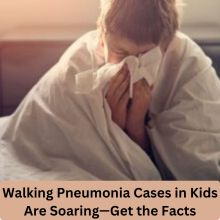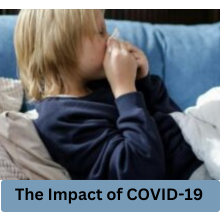
In recent months, there’s been a noticeable increase in cases of walking pneumonia among children, and the CDC has taken notice. As a parent or caregiver, you might be wondering what this means for your little ones. This article will break down the facts about walking pneumonia, why it’s surging, and what you can do to keep your kids safe and healthy.
What is Walking Pneumonia?
Walking pneumonia is a term often used to describe a mild case of pneumonia, primarily caused by the Mycoplasma pneumoniae bacteria. Unlike traditional pneumonia, which can make you feel very sick and require hospitalization, walking pneumonia allows individuals to remain relatively functional. Think of it like having a cold that refuses to go away—a persistent cough and some discomfort, but you can still get out of bed and go about your day.
Symptoms Associated with Walking Pneumonia
So, what should you look out for? Common symptoms include:
- Persistent Cough: Typically dry and non-productive.
- Low-Grade Fever: You might notice a slight increase in temperature.
- Fatigue: A general feeling of tiredness that doesn’t seem to fade.
- Sore Throat and Headache: These symptoms often accompany the cough.
Why Should We Care?
Understanding walking pneumonia is crucial, especially as cases rise. It’s often overlooked because it doesn’t present as severely as traditional pneumonia, but it can still lead to complications, especially in young children.
Current Surge in Cases
According to recent reports from the CDC, cases of walking pneumonia in children have surged significantly this year. For example, ER visits for pneumonia in kids aged 2 to 4 rose from 1% in April to 7.2% by early October. This staggering increase has caught the attention of healthcare professionals nationwide.
Causes of the Surge
The primary culprit behind this surge is the Mycoplasma pneumoniae bacteria. It’s important to note that various factors have contributed to this increase, including:
- Return to Pre-Pandemic Rates: After COVID-19, infections like these are returning to levels seen before the pandemic.
- Cyclic Nature of Infections: Mycoplasma infections tend to follow a pattern, with spikes every 3 to 7 years.
- Improved Diagnostics: New testing methods have made it easier to detect this type of pneumonia, leading to higher reported cases.
Identifying Symptoms
Recognizing the symptoms early can be a game-changer. Children may exhibit symptoms like:
- Gradual Onset of Cough: Over two to three weeks, the cough can escalate and become nearly constant.
- Non-Specific Initial Symptoms: Kids might start with a sore throat and headache, which can confuse parents.
Being aware of these signs can help in seeking timely medical intervention.
Diagnostic Challenges
One of the challenges in dealing with walking pneumonia is that it often goes undiagnosed initially. Traditional tests may not pick up Mycoplasma since it doesn’t grow well in standard cultures. However, advancements in diagnostic testing, like multiplex tests, have made it easier to identify these infections quickly.
Treatment Options
Parents might wonder how to treat walking pneumonia effectively. Unfortunately, first-line antibiotics like amoxicillin aren’t effective against Mycoplasma pneumoniae. Instead, healthcare providers often prescribe:
- Azithromycin: A commonly used antibiotic that works well against these bacteria.
- Other alternatives that are proven to be effective.
The Role of Pediatricians
Pediatricians are on the front lines of this health issue. Many are adjusting their treatment plans based on the new data, emphasizing the importance of accurate diagnoses to ensure children receive the correct medication.
Also read: Walmart’s Black Friday Deals: Don’t Miss These Surprises
Preventive Measures
As a parent, you might be asking, “How can I prevent this?” Here are some helpful tips:
- Vaccinations: Ensure your children are up to date on their vaccines.
- Hygiene Practices: Teach kids the importance of washing hands frequently.
- Avoid Crowded Spaces: If possible, keep children away from crowded environments during peak illness seasons.
The Impact of COVID-19
The pandemic has undoubtedly changed the landscape of respiratory infections. During COVID-19, many common infections dropped significantly, leading to a current resurgence. It can feel alarming, but understanding that these rates are returning to pre-pandemic levels can provide some perspective.
Seasonal Trends
Certain times of the year are notorious for respiratory illnesses. Fall and winter often see spikes in pneumonia cases due to increased indoor gatherings and lower ventilation. Understanding these trends can help you prepare.
Long-Term Effects
While most children recover without severe complications, it’s essential to keep an eye out for those with pre-existing conditions like asthma. In rare cases, untreated Mycoplasma infections can lead to complications affecting areas outside the lungs.
Expert Opinions
Healthcare professionals emphasize the need for increased awareness and understanding of walking pneumonia. Dr. Geoffrey Weinberg from the University of Rochester Medical Center points out the importance of education for parents and caregivers, as well as prompt action when symptoms arise.
Also read: Tragic Surfing Accident: 36-Year-Old Woman Impaled
Conclusion
As cases of walking pneumonia surge among children, it’s vital for parents to stay informed. By recognizing the symptoms, understanding treatment options, and implementing preventive measures, you can help keep your kids healthy this season. Remember, when in doubt, consult with a healthcare professional.
FAQs
What is walking pneumonia?
Walking pneumonia is a mild form of pneumonia typically caused by Mycoplasma pneumoniae bacteria.
How can I tell if my child has walking pneumonia?
Look for symptoms like a persistent dry cough, low-grade fever, fatigue, and sore throat.
What treatments are available for walking pneumonia?
Treatment often involves antibiotics like azithromycin, as traditional antibiotics like amoxicillin are ineffective.
Is walking pneumonia contagious?
Yes, it spreads through respiratory droplets, especially in crowded settings.
What preventive measures can I take?
Ensure vaccinations are up to date, practice good hygiene, and avoid crowded spaces when possible.

